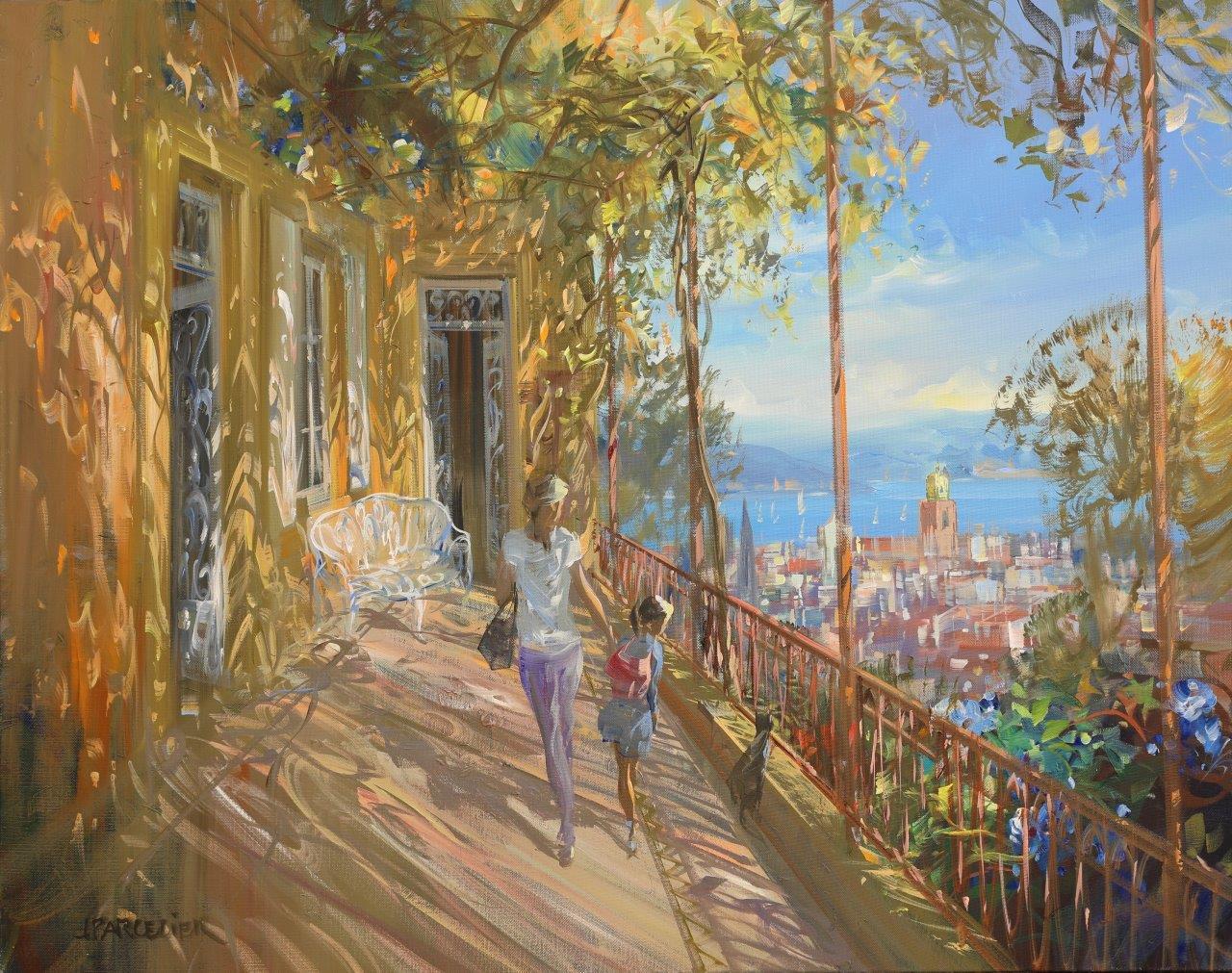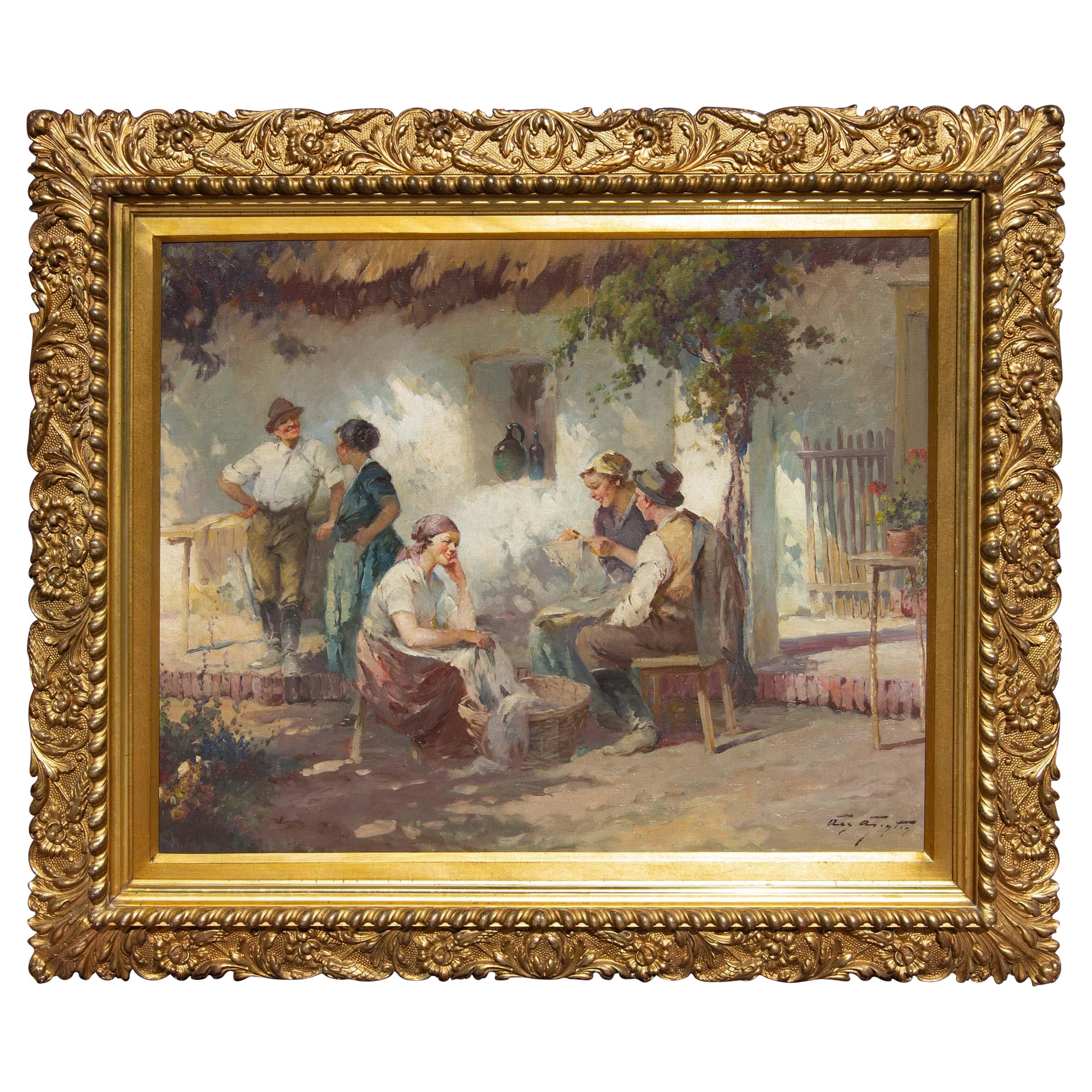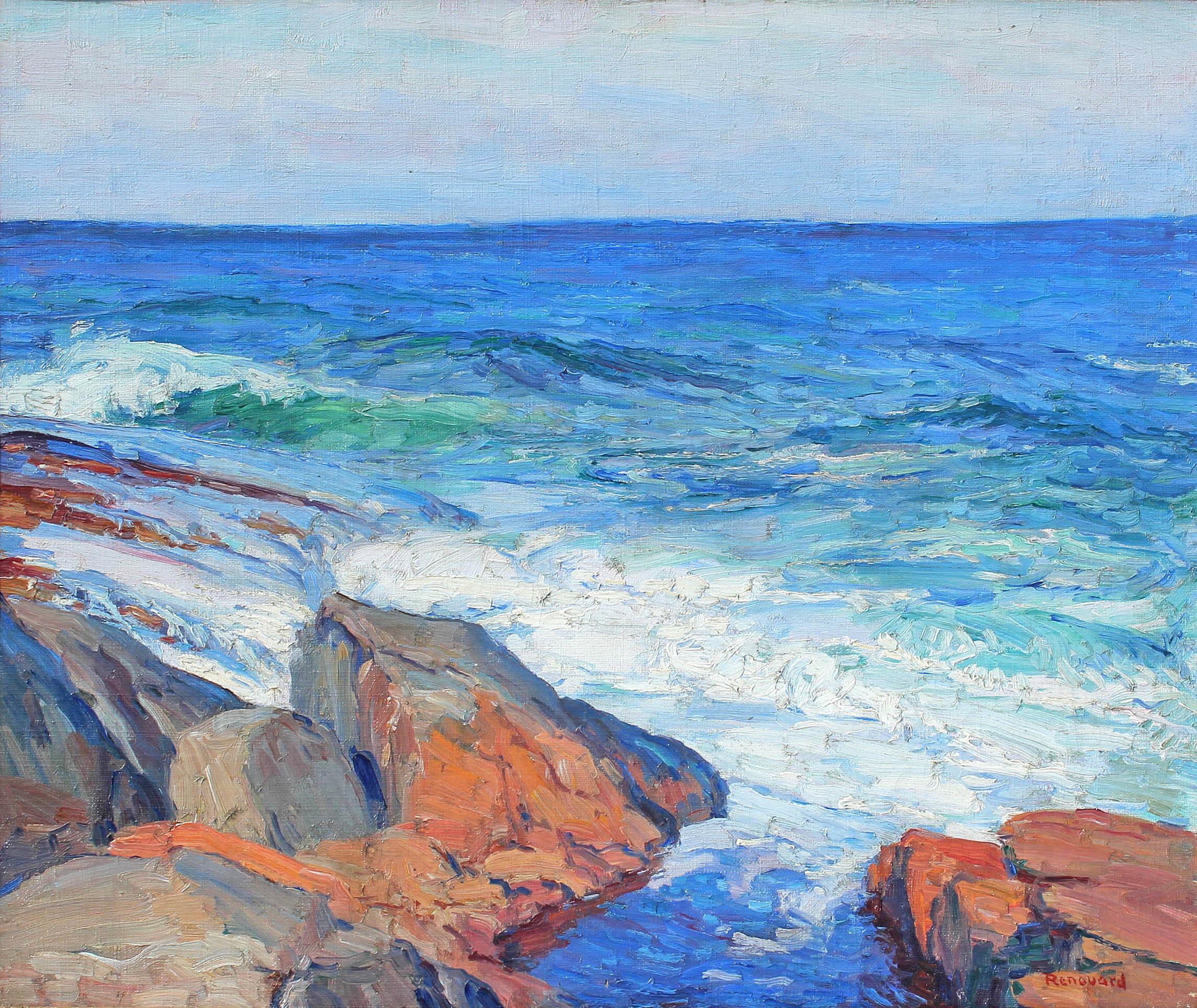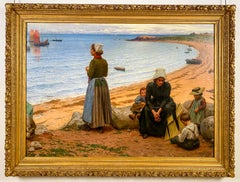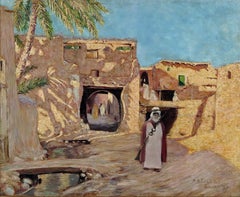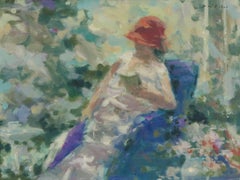
Reading in the Garden
View Similar Items
Want more images or videos?
Request additional images or videos from the seller
1 of 6
André GissonReading in the Garden1960's
1960's
About the Item
- Creator:André Gisson (1929-2003, American)
- Creation Year:1960's
- Dimensions:Height: 19 in (48.26 cm)Width: 23 in (58.42 cm)Depth: 2 in (5.08 cm)
- Medium:
- Movement & Style:
- Period:
- Condition:
- Gallery Location:Sheffield, MA
- Reference Number:Seller: Art G2381stDibs: LU70032523341
André Gisson
André Gisson was born 'Anders Gittelson' in 1921 in Brooklyn, New York. A widely-collected American Impressionist painter, he is known for landscape, still life, portrait and figure paintings. In order to be seen as belonging to the French Impressionist movement, he claimed to be a Frenchman born in 1910, and adopted the artist name 'André Gisson'. He lived in New York, Westport, Connecticut and France for much of his life, and traveled widely. He studied at the prestigious Pratt Institute in New York. After graduation, he joined the United States Army and become a captain during World War II. Gisson continued his studies in Europe, where he came under the influence of the great French impressionists. Upon his return to New York, he adapted the style and technique of impressionism and used small, broken brushwork and soft and vibrant colors. Gisson's landscapes and beach scenes depict the French countryside, where he painted every summer, and the region around Lake Mahopac in upstate New York, where he lived for many years. Gisson's still life compositions show a Japanese influence in his work; whereas the French influence is more pronounced in his landscapes and figures. Several of Gisson’s paintings have been published and distributed internationally. His works have been exhibited in leading art galleries throughout the country for over four decades, as a solo show extended from New York, Washington, Philadelphia, Texas and California, also overseas locations in London, Paris and Tokyo. His work are part of the collections of the Smithsonian Institution and the Triton Museum of Art, in North Carolina. Among his private collectors were President Lyndon B. Johnson and W. Somerset Maugham. Gisson died in 2003 in Atlanta, Georgia. He was listed in The Artist's Yearbook (p. 332, 2000), Artists in the Southwest Art (p. 64, 1993) and Who Was Who in American Art (p. 1296, 1999).
About the Seller
3.7
Vetted Seller
These experienced sellers undergo a comprehensive evaluation by our team of in-house experts.
1stDibs seller since 2017
46 sales on 1stDibs
More From This SellerView All
- A Day at the BeachLocated in Sheffield, MALeonce De Joncieres French, 1871-1947 A Day at the Beach Oil on canvas Signed and dated 'L. de Joncieres/ 1903' (lower right) 46 1/2 by 65¼ in. W/f...Category
Early 1900s Impressionist Landscape Paintings
MaterialsOil
- Biskra AlgeriaBy Arthur George CollinsLocated in Sheffield, MAArthur George Collins American, b.1866 Biskra Algeria Oil on canvas Signed and dated Biskra, 1893 26 ½ by 32 ½ in. W/frame 32 ½ by 38 ½ in. Arthur studied at the Julien Academy, P...Category
1890s Impressionist Landscape Paintings
MaterialsOil
- The Three KingsLocated in Sheffield, MAHenry Dele Coeuillerie American, 1864-1932 The Three Kings Oil on canvas Signed & dated lower right 30 by 36 in. W/frame 35 ½ by 41 ½ in. Provenance...Category
Early 20th Century American Impressionist Figurative Paintings
MaterialsOil
- Young Girl Resting in a Bed of FlowersLocated in Sheffield, MAJames George Weiland American, 1872-1968 Young Girl Resting in a Bed of Flowers Oil on canvas 24 by 30 in. W/frame 30 by 36 in. Signed lower left...Category
1910s American Impressionist Figurative Paintings
MaterialsOil
- BathersBy John Edward CostiganLocated in Sheffield, MAJohn Edward Costigan, N.A. American, 1888-1972 Bathers Oil on canvas Signed ‘J.E. Costigan N.A.’ lower left 20 by 24 in. W/frame 26 by 30 in. John Costigan was born of Irish-American parents in Providence, Rhode Island, February 29, 1888. He was a cousin of the noted American showman, George M. Cohan, whose parents brought the young Costigan to New York City and was instrumental in starting him on a career in the visual arts. They were less successful in encouraging him to pursue formal studies at the Art Students League (where, however, he later taught) than in exposing him to the commercial art world through the job they had gotten him with the New York lithographing firm that made their theatrical posters. At the H. C. Miner Lithographing Company, Costigan worked his way up from his entry job as a pressroom helper, through various apprenticeships, to the position of sketch artist. In the latter capacity he was an uncredited designer of posters for the Ziegfeld Follies and for numerous silent films. Meanwhile, he had supplemented his very meager formal studies in the fine arts with a self-teaching discipline that led to his first professional recognition in 1920 with the receipt of prizes for an oil painting and watercolor in separate New York exhibitions. A year earlier, Costigan had wed professional model Ida Blessin, with whom he established residence and began raising a family in the sleepy little rural New York hamlet of Orangeburg, the setting for the many idyllic farm landscapes and wood interiors with which he was to become identified in a career that would span half a century. John Costigan’s first national recognition came in 1922 with his winning of the coveted Peterson Purchase prize of the Art Institute of Chicago for an oil on canvas, “Sheep at the Brook.” It marked the start of an unbroken winning streak that would gain him at least one important prize per year for the remainder of the decade. The nation’s art journalists and critics began to take notice, making him the recurring subject of newspaper features and magazine articles. The eminent author and critic Edgar Holger Cahill was just a fledgling reporter when he wrote his first feature, “John Costigan Carries the Flame,” for Shadowland Magazine in 1922. Costigan had his first one-man show of paintings at the Rehn Gallery on New York’s 5th Avenue in November, 1924, to be followed less than three years later by another at the Art Institute of Chicago. In addition, Costigan’s work has been—and continues to be included, side-by-side with that of some of America’s most high-profile artists, in museum and gallery exhibitions throughout the country. His renown had peaked in the early 1930s, by which time his work had been honored with nearly every major award then being bestowed in the fine arts and had been acquired for the permanent collections of several prestigious American museums, including New York’s Metropolitan (which only recently, in 1997, deaccessioned his “Wood Interior,” acquired in 1934). Although Costigan’s celebrity had ebbed by the late 1930s, the Smithsonian Institution saw fit in 1937 to host an exhibition exclusively of his etchings. And, in 1941, the Corcoran Gallery (also Washington, D.C.) similarly honored him for his watercolors. (Another Washington institution, the Library of Congress, today includes 22 Costigan etchings and lithographs in its permanent print collection.) During World War II, Costigan returned briefly to illustrating, mainly for Bluebook, a men’s pulp adventure magazine. A gradual revival of interest in his more serious work began at the end of the war, culminating in 1968 with the mounting of a 50-year Costigan retrospective at the Paine Art Center and Arboretum in Oshkosh, Wisconsin. Oils, watercolors and prints were borrowed from museums and private collections throughout the country, and the exhibition was subsequently toured nationally by the Smithsonian Institution. John Costigan died of pneumonia in Nyack, NY, August 5, 1972, just months after receiving his final prestigious award —the Benjamin West Clinedinst Medal of the Artist’s Fellowship, Inc., presented in general recognition of his “...achievement of exceptional artistic merit...” in the various media he had mastered in the course of his career. This painting depicts one of the artist's favorite themes --the farm family bathing...Category
1950s Post-Impressionist Figurative Paintings
MaterialsOil
- Woman and ChildBy John Edward CostiganLocated in Sheffield, MAJohn Edward Costigan, N.A. American, 1888-1972 Woman and Child Oil on canvas Signed ‘J.E. Costigan N.A.’ lower left 24 by 30 in. W/frame 32 by 38 in. John Costigan was born of Irish-American parents in Providence, Rhode Island, February 29, 1888. He was a cousin of the noted American showman, George M. Cohan, whose parents brought the young Costigan to New York City and was instrumental in starting him on a career in the visual arts. They were less successful in encouraging him to pursue formal studies at the Art Students League (where, however, he later taught) than in exposing him to the commercial art world through the job they had gotten him with the New York lithographing firm that made their theatrical posters. At the H. C. Miner Lithographing Company, Costigan worked his way up from his entry job as a pressroom helper, through various apprenticeships, to the position of sketch artist. In the latter capacity he was an uncredited designer of posters for the Ziegfeld Follies and for numerous silent films. Meanwhile, he had supplemented his very meager formal studies in the fine arts with a self-teaching discipline that led to his first professional recognition in 1920 with the receipt of prizes for an oil painting and watercolor in separate New York exhibitions. A year earlier, Costigan had wed professional model Ida Blessin, with whom he established residence and began raising a family in the sleepy little rural New York hamlet of Orangeburg, the setting for the many idyllic farm landscapes and wood interiors with which he was to become identified in a career that would span half a century. John Costigan’s first national recognition came in 1922 with his winning of the coveted Peterson Purchase prize of the Art Institute of Chicago for an oil on canvas, “Sheep at the Brook.” It marked the start of an unbroken winning streak that would gain him at least one important prize per year for the remainder of the decade. The nation’s art journalists and critics began to take notice, making him the recurring subject of newspaper features and magazine articles. The eminent author and critic Edgar Holger Cahill was just a fledgling reporter when he wrote his first feature, “John Costigan Carries the Flame,” for Shadowland Magazine in 1922. Costigan had his first one-man show of paintings at the Rehn Gallery on New York’s 5th Avenue in November, 1924, to be followed less than three years later by another at the Art Institute of Chicago. In addition, Costigan’s work has been—and continues to be included, side-by-side with that of some of America’s most high-profile artists, in museum and gallery exhibitions throughout the country. His renown had peaked in the early 1930s, by which time his work had been honored with nearly every major award then being bestowed in the fine arts and had been acquired for the permanent collections of several prestigious American museums, including New York’s Metropolitan (which only recently, in 1997, deaccessioned his “Wood Interior,” acquired in 1934). Although Costigan’s celebrity had ebbed by the late 1930s, the Smithsonian Institution saw fit in 1937 to host an exhibition exclusively of his etchings. And, in 1941, the Corcoran Gallery (also Washington, D.C.) similarly honored him for his watercolors. (Another Washington institution, the Library of Congress, today includes 22 Costigan etchings and lithographs in its permanent print collection.) During World War II, Costigan returned briefly to illustrating, mainly for Bluebook, a men’s pulp adventure magazine. A gradual revival of interest in his more serious work began at the end of the war, culminating in 1968 with the mounting of a 50-year Costigan retrospective at the Paine Art Center and Arboretum in Oshkosh, Wisconsin. Oils, watercolors and prints were borrowed from museums and private collections throughout the country, and the exhibition was subsequently toured nationally by the Smithsonian Institution. John Costigan died of pneumonia in Nyack, NY, August 5, 1972, just months after receiving his final prestigious award —the Benjamin West Clinedinst Medal of the Artist’s Fellowship, Inc., presented in general recognition of his “...achievement of exceptional artistic merit...” in the various media he had mastered in the course of his career. This painting depicts one of the artist's favorite themes --the farm family bathing...Category
1940s Post-Impressionist Landscape Paintings
MaterialsOil
You May Also Like
- Italian Impressionist Oil on Board Marine Landscape Painting Naples Bay ViewBy Francesco Coppola CastaldoLocated in Firenze, ITEveryday fishermen life is captured in this wonderful Italian impressionist late 19th century oil painting on thin board titled fishermen ashore. We love the neutral and natural colo...Category
Late 19th Century Impressionist Landscape Paintings
MaterialsBoard, Oil
- Cloudy landscape. Oil sketch on cardboard. Unsigned.By Jules Pierre van BiesbroeckLocated in Paris, FRCloudy landscape. Oil sketch on cardboard. Unsigned. This work will be recorded in the catalogue raisonné of the work of the artist currently in preparation. Jules Van Biesbroeck was the son of Jules Evariste van Biesbroeck, a painter of Ghent, but was born in Italy, in Portici, near Naples, while his parents were staying there. (In the 19th century many artists made educational trips to Italy). It was a long visit: the child was two years old by the time the family returned to Ghent.[1] After a short period of practice with his father, van Biesbroeck was enrolled in the Academy of Fine Arts in Ghent. His first painting, "The Shepherd" (French: Le pâtre), was sold at the Triennale in Ghent. In 1888, when he was only 15 years old, he made his debut at the "Salon des Champs-Elysées" in Paris with his monumental work "The Launch of the Argo" (French: Le lancement...Category
Early 20th Century Impressionist Landscape Paintings
MaterialsOil
- 'Agay, le château et le Sémaphore'. Oil on canvas. Signed.By Armand GuillauminLocated in Paris, FR'Agay, le château et le Sémaphore'. Oil on canvas. +/- 1922 Signed lower right Measurements : 60 x 73 cm. This painting will be recorded in the second volume of the Catalogue Raisonn...Category
1920s Impressionist Landscape Paintings
MaterialsOil
- Coastal SceneBy Sigurd Solver SchouLocated in New York, NYCoastal Scene by Sigurd Solver Schou (1875-1944) Oil on panel 10 x 13 inches unframed ( 25.4 x 33.02 cm) 14 ½ x 17 ⅛ inches framed (36.83 x 43.4975 cm)...Category
20th Century Impressionist Landscape Paintings
MaterialsOil
- Impressionist: 'Young Friends by the Beach watching Fishermen' oil circa 1950'sLocated in Frome, SomersetA fine Impressionist oil, ' Young Friends by the Beach Watching Fishermen' circa 1950's. oil on canvas 43cm x 53cm Good quality gallery frame 52cmx62cm ...Category
1950s Impressionist Landscape Paintings
MaterialsOil
- Ralph R. Stubbs - Low tide at Sunset - English 19th Century Marine Oil PaintingBy Ralph Reuben / Ruben StubbsLocated in Meinisberg, CHRalph Reuben/Ruben Stubbs (English, 1824-1879) Low Tide at Sunset • 19thC Oil on artist board (card) ca. 21 x 36.5 cm • Signed bottom right and verso Biografie: Stubbs Ralph Reu...Category
1860s Impressionist Landscape Paintings
MaterialsOil, Cardboard
Recently Viewed
View AllMore Ways To Browse
Antique French Painting Impressionism
Antique American Impressionism
Andre Gisson Paintings
Andre Gisson
Gisson Oil On Canvas
Artist Gisson
Anders Gisson
Early American Window
Native Woman
Wpa New York
Miniature Scene
Cannes Painting
Pair Of Figurative Paintings
Black Female Painter
Basquiat Style Painting
M M Michel
Old French Street Painting
Renaissance Oil On Canvas



